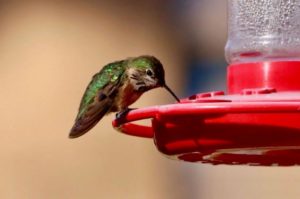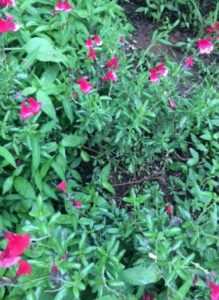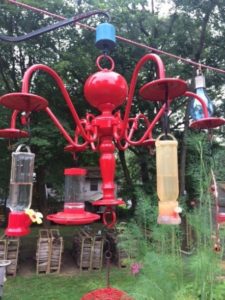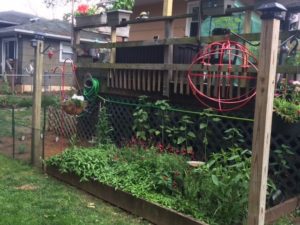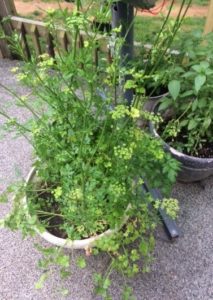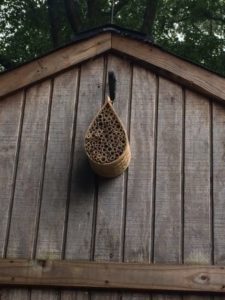Monarchs: Inside or Out?
May 8, 2019Reflections on Gardening for Wildlife
June 13, 2019Jennifer Crews-Carey
Our 2019 second quarter Habitat Hero winner is Jennifer Crews-Carey. Last November Cal the Calliope Hummingbird craze begun in Jennifer’s backyard. She was fortunate to have a vagrant hummingbird-the Calliope Hummingbird that is typically only seen on the West Coast-show up in her yard. Her husband pointed out the bird, Jennifer snapped a picture and they posted it on a MD Birding page, thinking it was only our East coast hummingbird the Ruby-throated Hummingbird. A birding expert commented to her that he didn’t believe it was a Ruby-throated and wanted to come out to confirm. An expert from the Patuxent Wildlife Research Center in Laurel came out to verify, band, weigh and measure Cal. He was indeed a vagrant Calliope, somehow way off course from his usual habitat. Jennifer and her husband Rusty set about making their yard the perfect habitat for their unusual visitor by providing lots of sugar water, perching areas, water and shelter for the cold nights. They also opened up their yard to anyone who wanted a glimpse of this unique visitor. People made the trek from as far as VA, NJ, and NY. Some came from worldwide places while already in the area. Cal soon developed his magenta rays of his gorget throat feathers.
Cal (by Jack Anderson)
Many experts warned he could soon take off-in search of a mate as he was maturing. As the end of December rolled around Cal could no longer be seen in Jennifer’s yard, but she continued making a welcoming environment in case he was still lurking in the area. Since his disappearance in December he still has not been seen in the Cape but his visit sparked Jennifer’s interest in her backyard birds. While she had provided seed and housing for birds, she became even more impassioned about her feathered friends as well as seeing what other wildlife she could attract.
This spring Jennifer has added a large patch of milkweed, the host plant for monarchs to her backyard oasis as well as much needed nectar plants for the monarchs after they emerge as adults. While the caterpillars require milkweed to eat as they grow, the butterflies need nectar plants to fuel up, particularly fall blooming plants as they begin to migrate. Asters, Goldenrod and Joe-Pye Weed are all excellent examples of native fall blooming nectar sources. In addition to her milkweed garden Jennifer has several other native plants such as moss phlox, black eyed-Susan, and spiderwort as well as several hummingbird friendly plants like Pineapple Sage. They have set up a variety of hummingbird feeders ranging in sizes and shapes, hung in whimsical ways. There are several old chandeliers, painted red that now house hummingbird feeders. She cleans and refills them every few days (which usually prompts it to rain!).

In addition to the hummingbird feeders there are seed feeders for the songbirds, a bird bath providing water and several houses that are occupied! While I was there we heard and saw a delightful catbird with his brazen attitude. Her large variety of potted herbs are offered up as host plants for the swallowtail caterpillar-including dill, parsley and fennel. Jennifer & Rusty’s yard is a welcoming habitat to many of our local fauna! As they continue to add more native plants they will increase the biodiversity in their yard! Thanks Jennifer and Rusty for being a Habitat Hero!



